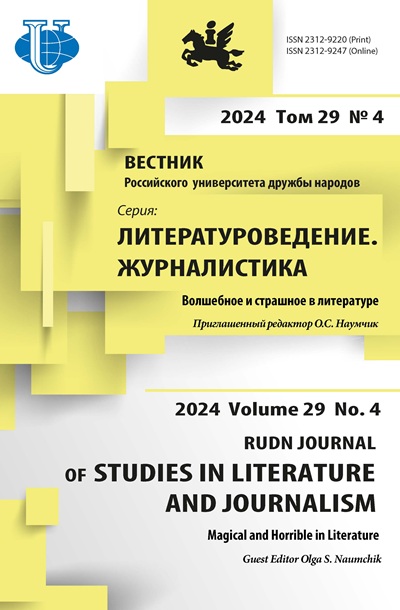Stylization of history in the works of N.V. Kukolnik
- Authors: Kubasov A.V.1
-
Affiliations:
- Ural State Pedagogical University
- Issue: Vol 29, No 4 (2024): MAGICAL AND HORRIBLE IN LITERATURE
- Pages: 711-725
- Section: LITERARY CRITICISM
- URL: https://journals.rudn.ru/literary-criticism/article/view/42291
- DOI: https://doi.org/10.22363/2312-9220-2024-29-3-711-725
- EDN: https://elibrary.ru/QLEMYP
Cite item
Full Text
Abstract
Examines the concept of “Stylization of History” and its application through the forgotten works of mid-19th-century author Nestor Vasilyevich Kukolnik. This concept is characterized by a free interpretation of the past in a figurative manner, while still maintaining reliance on well-known facts, events, or qualities of historical figures, expressed within a specific stylistic framework. If the notion of truth is pertinent to history, then relative verisimilitude is significant for Stylization of History. Kukolnik’s inclination towards stylization is attributed to his life circumstances and his aesthetic sensibilities as a writer, establishing that the portrayal of the past in his artistic endeavors was connected and influenced by the work of his friends - artist K.P. Bryullov and composer M.I. Glinka. The stylization is closely linked to the phenomena of archaization and the writer’s inclination towards literary examples from the past. It is observed that as early as the 1830s, a realistic trend started to emerge in Russian literature, but for the staunch conservative Kukolnik, the works of Western European romantics continued to serve as his models. The classic writers’ viewpoint on Kukolnik’s work is outlined, with most of them offering critical assessments. Through the analysis of the short story Sergeant Ivan Ivanovich Ivanov, or All as One , the embodiment of historical stylization in a work of art is revealed. The potential for renewed interest in Kukolnik’s work is also discussed, suggesting that his works could be reimagined in the language of modern genre forms.
Keywords
About the authors
Alexandr V. Kubasov
Ural State Pedagogical University
Author for correspondence.
Email: kubas2002@mail.ru
ORCID iD: 0000-0001-9074-1133
Grand PhD in Philology, Professor of the Department of Theory and Methods of Teaching Persons with Disabilities
26 Cosmonauts Ave., Ekaterinburg, 620017, Russian FederationReferences
- Andreev, Yu.V. (1999). Tyrants and heroes. Historical stylization in the political practice of elder tyranny. Herald of Ancient History, (1), 3–7. (In Russ.)
- Anosova, O.G. (2012). Perception of W. Scott’s work by contemporaries in Russia. Bulletin of RUDN University. Series Educational Issues: Languages and Specialization, (3), 79–85. (In Russ.)
- B.a. (1914). Kukolnik, Nestor Vasilievich. Encyclopedic Dictionary of the Garnet Partnership. Vol. 26. Moscow. (In Russ.)
- Bakhtin, M.M. (1979). Problems of Dostoevsky’s poetics. Moscow: Soviet Russia Publ. (In Russ.)
- Bakhtin, M.M. (1986). Aesthetics of verbal creativity. Moscow: Art Publ. (In Russ.)
- Belinskiy, V.G. (1956). Complete works: in 13 vols. Vol. 10. Moscow: Publishing House of the USSR Academy of Sciences. (In Russ.)
- Berdyaev, N.A. (1991). About Russian philosophy. Sverdlovsk: Publishing house Ural. University. (In Russ.)
- Dostoevskiy, F.M. (1974). Complete works and letters: in 30 vosls. Essays. Moscow: Nauka Publ. (In Russ.)
- From the memoirs of N.V. Kukolnik (1891). Historical Bulletin. XLV, 79–99. (In Russ.)
- Kartsov, V.S. (1895). Kukolnik, (Nestor Vasilievich). Encyclopedic Dictionary of F.A. Brockhaus and I.A. Efron. Vol. 32. Saint Petersburg: Semenovskaya tipografiya Publ. (In Russ.)
- Kazakova, S. (2008). Karl Bryullov and Nestor Kukolnik: a story of two illustrations. Tretyakov Gallery. (4). (in Russ.) Retrieved from https://www.tg-m.ru/articles/4-2008-21/karl-bryullov-i-nestor-kukolnik-istoriya-dvukh-illyustratsii
- Kukol’nik, N. (1841). Tale after tale. Vol. 1–4. Saint Petersburg: Printing house K. Kraja. Publ (In Russ.)
- Kukol’nik, N.V. (1901). The Green Book: Letters from N.V. Kukolnik. Saint Petersburg: Publishing house of the company Society benefit. (In Russ.)
- Kuprin, A.I. (1986). In memory of Chekhov. Chekhov in the memoirs of his contemporaries. Moscow: Fiction. (In Russ.)
- Kurganov, E. (1995). Literary anecdote of the Pushkin era [Doctoral dissertation, Helsinki]. Khel’sinki, Slavica Helsingiensia, 15. (In Russ.) Retrieved from https://blogs.helsinki.fi/slavica-helsingiensia/files/2019/11/sh15-5.pdf
- Malyshkina, O. (2019). The hand of the Almighty in the fate of Nestor Puppeteer. Neva, (10), 208–218. (In Russ.)
- Manskov, O.V. (2011). Historical and mythological stylization in antiquity. Bulletin of TGPI named after. A.P. Chekhov. Series Humanities, (2), 272–274. (In Russ.)
- Nestor Kukol’nik. (2023). Website about the life and work of the great Russian write. (In Russ.) Retrieved from https://nestorkukolnik.wordpress.com
- Nikitenko, A.V. (1955). Diaryin: in 3 vols. Vol. 1. Moscow: GIHL. (In Russ.)
- Nikolaenko, A.I. (2005). N.V. Kukolnik (1809–1868). Rusin, (1), 118–138. (In Russ.)
- Okhotin, N.G., & Ranchin, A.M. (1994). Kukolnik, Nestor Vasilievich. Russian writers. 1800–1917. Biographical Dictionary. Vol. 3. Moscow: Publishing house Big Russian Encyclopedia. (In Russ.)
- Panaev, I.I. (1988). Literary Memoirs. Moscow: Publishing house Pravda. (In Russ.)
- Seychakovski, A. (2016). Images of Finland, Sweden and Russia in Nestor Kukolnik’s story “Egor Ivanovich Silvanovsky, or the conquest of Finland under Peter the Great”. Rocznik przemyski. Literatura i język, 52(2), 27–37. (In Russ.)
- Skabichevskiy, A.M. (1890). Essays. Critical sketches, journalistic essays, literary works: in 2 vols. Vol. 2. Saint Petersburg: Publishing house F. Pavlenkov. (In Russ.)
- Turgenev, I.S. (1994). Complete works and letters: in 30 vols. Letters: in 18 vols. Vol. 1. Moscow: Nauka. (In Russ.)
















